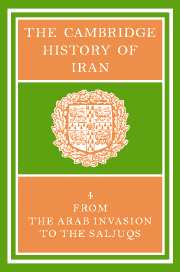Book contents
- Frontmatter
- 1 THE ARAB CONQUEST OF IRAN AND ITS AFTERMATH
- 2 THE ‘ABBĀSID CALIPHATE IN IRAN
- 3 THE ṬĀHIRIDS AND ṢAFFĀRIDS
- 4 The SĀMĀNIDS
- 5 THE EARLY GHAZNAVIDS
- 6 THE MINOR DYNASTIES OF NORTHERN IRAN
- 7 IRAN UNDER THE BŪYIDS
- 8 TRIBES, CITIES AND SOCIAL ORGANIZATION
- 9 THE VISUAL ARTS
- 10 NUMISMATICS
- 11 THE EXACT SCIENCES
- 12 LIFE SCIENCES, ALCHEMY AND MEDICINE
- 13(a) PHILOSOPHY AND COSMOLOGY
- (b) SŪFISM
- 14 THE RELIGIOUS SCIENCES
- 15 SECTS AND HERESIES
- 16 NĀSIR-I KHUSRAU AND IRANIAN ISMĀ‘ĪLĪSM
- 17 ZOROASTRIAN LITERATURE AFTER THE MUSLIM CONQUEST
- 18 ARABIC LITERATURE IN IRAN
- 19 THE RISE OF THE NEW PERSIAN LANGUAGE
- 20 (a) THE “RUBĀ'Ī” IN EARLY PERSIAN LITERATURE
- (b) ‘UMAR KHAYYĀM: ASTRONOMER, MATHEMATICIAN AND POET
- Bibliography
- Index
- Plate section
- Plate section">
- Map 1. Iran under the Abbasids">
- References
4 - The SĀMĀNIDS
Published online by Cambridge University Press: 28 March 2008
- Frontmatter
- 1 THE ARAB CONQUEST OF IRAN AND ITS AFTERMATH
- 2 THE ‘ABBĀSID CALIPHATE IN IRAN
- 3 THE ṬĀHIRIDS AND ṢAFFĀRIDS
- 4 The SĀMĀNIDS
- 5 THE EARLY GHAZNAVIDS
- 6 THE MINOR DYNASTIES OF NORTHERN IRAN
- 7 IRAN UNDER THE BŪYIDS
- 8 TRIBES, CITIES AND SOCIAL ORGANIZATION
- 9 THE VISUAL ARTS
- 10 NUMISMATICS
- 11 THE EXACT SCIENCES
- 12 LIFE SCIENCES, ALCHEMY AND MEDICINE
- 13(a) PHILOSOPHY AND COSMOLOGY
- (b) SŪFISM
- 14 THE RELIGIOUS SCIENCES
- 15 SECTS AND HERESIES
- 16 NĀSIR-I KHUSRAU AND IRANIAN ISMĀ‘ĪLĪSM
- 17 ZOROASTRIAN LITERATURE AFTER THE MUSLIM CONQUEST
- 18 ARABIC LITERATURE IN IRAN
- 19 THE RISE OF THE NEW PERSIAN LANGUAGE
- 20 (a) THE “RUBĀ'Ī” IN EARLY PERSIAN LITERATURE
- (b) ‘UMAR KHAYYĀM: ASTRONOMER, MATHEMATICIAN AND POET
- Bibliography
- Index
- Plate section
- Plate section">
- Map 1. Iran under the Abbasids">
- References
Summary
The original home of the Sāmānids is uncertain, for some Arabic and Persian books claim that the name was derived from a village near Samarqand, while others assert it was a village near Balkh or Tirmidh. The latter is a shade more probable since the earliest appearance of the Sāmānid family in the sources seems to be in Khurāsān rather than in Transoxiana. In some sources the Sāmānids claimed to be descended from the noble Sasanian family of Bahrām Chūbīn, whereas one author claimed that they were of Turkish origin and. belonged to the Oghuz tribe, which is most unlikely, but conceivably may be a later attempt to link them to a Hephthalite or Turkish origin. All traditions relating to the origin of the dynasty, however, have it that Sāmān accepted Islam from Asad b. ‘Abd-Allāh al-Qasrī (or Qushairī), governor of Khurāsān 105–9/723–7, for subsequently Sāmān named his son Asad after the governor. We hear no more of Asad until the time of al-Ma'mūn, when his governor of Khurāsān, Ghassān b. ‘Abbād, rewarded the four sons of Asad for their support of al-Ma'mūn against a rebel Rāfi‘ b. Laith. This was about the year 204/819, and the four sons of Asad were appointed over the following cities: Nūh - Samarqand, Ahmad - Farghāna, Yahyā - Shāsh and Ilyās - Herāt. This assignment of rule to the sons of Asad marked the beginning of Sāmānid power in Transoxiana, for the line of Ilyās in Herat did not fare as well as did his brothers in the north. Ilyās died in 242/856 and his son Ibrāhīm took his place in Herāt.
- Type
- Chapter
- Information
- The Cambridge History of Iran , pp. 136 - 161Publisher: Cambridge University PressPrint publication year: 1975
References
- 13
- Cited by

